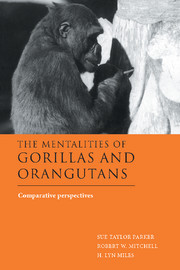Book contents
- Frontmatter
- Contents
- List of contributors
- Preface
- Acknowledgments
- I Comparative evolutionary and developmental perspectives on gorillas and orangutans
- II Cognition and tool use in gorillas and orangutans
- 4 Intelligent tool use in wild Sumatran orangutans
- 5 Orangutans' imitation of tool use: a cognitive interpretation
- 6 Object manipulation and skill organization in the complex food preparation of mountain gorillas
- 7 Development of sensorimotor intelligence in infant gorillas: the manipulation of objects in problem-solving and exploration
- 8 Tool use in captive gorillas
- 9 A survey of tool use in zoo gorillas
- III Communication in gorillas and orangutans
- IV Social cognition in gorillas and orangutans
- V Epilogue
- Index of authors
- Index of subjects
5 - Orangutans' imitation of tool use: a cognitive interpretation
Published online by Cambridge University Press: 20 October 2009
- Frontmatter
- Contents
- List of contributors
- Preface
- Acknowledgments
- I Comparative evolutionary and developmental perspectives on gorillas and orangutans
- II Cognition and tool use in gorillas and orangutans
- 4 Intelligent tool use in wild Sumatran orangutans
- 5 Orangutans' imitation of tool use: a cognitive interpretation
- 6 Object manipulation and skill organization in the complex food preparation of mountain gorillas
- 7 Development of sensorimotor intelligence in infant gorillas: the manipulation of objects in problem-solving and exploration
- 8 Tool use in captive gorillas
- 9 A survey of tool use in zoo gorillas
- III Communication in gorillas and orangutans
- IV Social cognition in gorillas and orangutans
- V Epilogue
- Index of authors
- Index of subjects
Summary
INTRODUCTION
Imitation and tool use have both been portrayed as key abilities shaping the evolution of the human mind. The two combined – imitation of tool use – may have even greater significance. Imitation of tool use may represent a more advanced ability than imitation per se (Mitchell, 1994) and imitation may have been instrumental in promoting the acquisition and spread of tool use in hominids (e.g., Parker & Gibson, 1979; Visalberghi, 1993b). Whether any nonhuman species can imitate tool use, then, has implications for models of intelligence within the primate order, particularly evolutionary ones. The possibility that nonhumans can has begun to loom large with the increasing number of studies showing that great apes can imitate and use tools to unexpectedly sophisticated levels of complexity. This raises the credibility of the many claims of imitative tool use in great apes that have accumulated through the twentieth century.
Some newer work on imitation since the late 1980s has challenged the credibility these claims. First, great apes have independently acquired the types of tool use that were ostensibly imitatively learned (e.g., Nash, 1982; Paquette, 1992). Resemblances between great apes' tool strategies and demonstrated tool strategies could, then, derive from similarities in the affordances of the tools and the demands of the problem, that is, environmental contingencies that guide individual learning along similar paths (e.g., Galef, 1990, 1992; Whiten & Ham, 1992; Nagell, Olguin, & Tomasello, 1993; Call & Tomasello, 1994, 1995; Tomasello, 1996).
Information
- Type
- Chapter
- Information
- The Mentalities of Gorillas and OrangutansComparative Perspectives, pp. 117 - 146Publisher: Cambridge University PressPrint publication year: 1999
Accessibility standard: Unknown
Why this information is here
This section outlines the accessibility features of this content - including support for screen readers, full keyboard navigation and high-contrast display options. This may not be relevant for you.Accessibility Information
- 10
- Cited by
